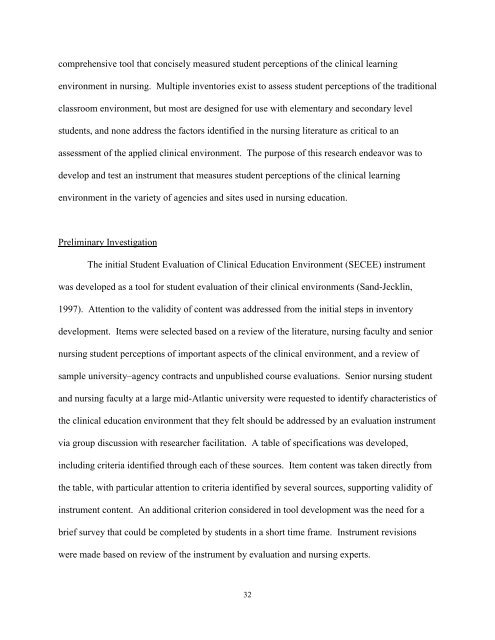STUDENT EVALUATION OF CLINICAL EDUCATION ENVIRONMENT
STUDENT EVALUATION OF CLINICAL EDUCATION ENVIRONMENT
STUDENT EVALUATION OF CLINICAL EDUCATION ENVIRONMENT
You also want an ePaper? Increase the reach of your titles
YUMPU automatically turns print PDFs into web optimized ePapers that Google loves.
comprehensive tool that concisely measured student perceptions of the clinical learning<br />
environment in nursing. Multiple inventories exist to assess student perceptions of the traditional<br />
classroom environment, but most are designed for use with elementary and secondary level<br />
students, and none address the factors identified in the nursing literature as critical to an<br />
assessment of the applied clinical environment. The purpose of this research endeavor was to<br />
develop and test an instrument that measures student perceptions of the clinical learning<br />
environment in the variety of agencies and sites used in nursing education.<br />
Preliminary Investigation<br />
The initial Student Evaluation of Clinical Education Environment (SECEE) instrument<br />
was developed as a tool for student evaluation of their clinical environments (Sand-Jecklin,<br />
1997). Attention to the validity of content was addressed from the initial steps in inventory<br />
development. Items were selected based on a review of the literature, nursing faculty and senior<br />
nursing student perceptions of important aspects of the clinical environment, and a review of<br />
sample university–agency contracts and unpublished course evaluations. Senior nursing student<br />
and nursing faculty at a large mid-Atlantic university were requested to identify characteristics of<br />
the clinical education environment that they felt should be addressed by an evaluation instrument<br />
via group discussion with researcher facilitation. A table of specifications was developed,<br />
including criteria identified through each of these sources. Item content was taken directly from<br />
the table, with particular attention to criteria identified by several sources, supporting validity of<br />
instrument content. An additional criterion considered in tool development was the need for a<br />
brief survey that could be completed by students in a short time frame. Instrument revisions<br />
were made based on review of the instrument by evaluation and nursing experts.<br />
32












